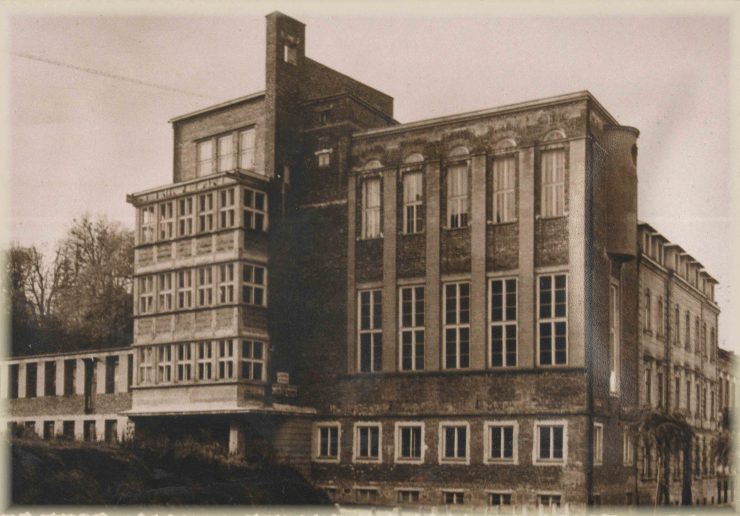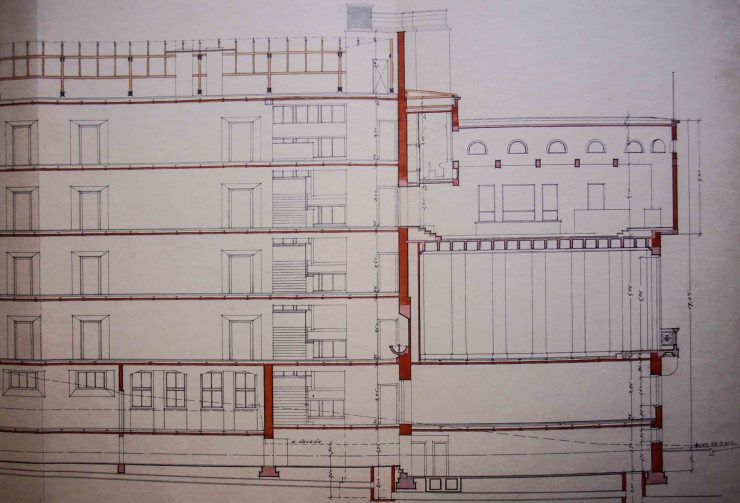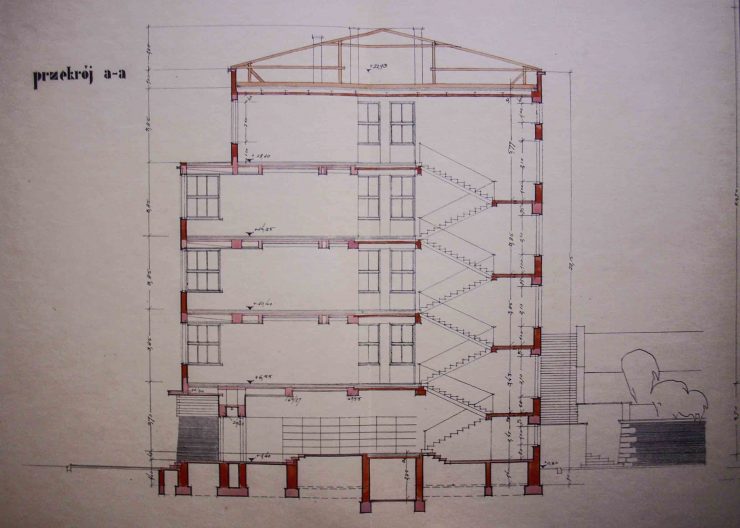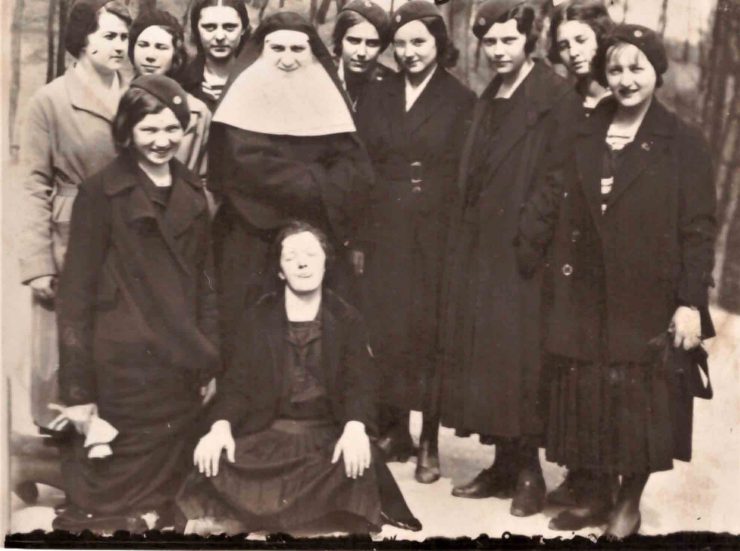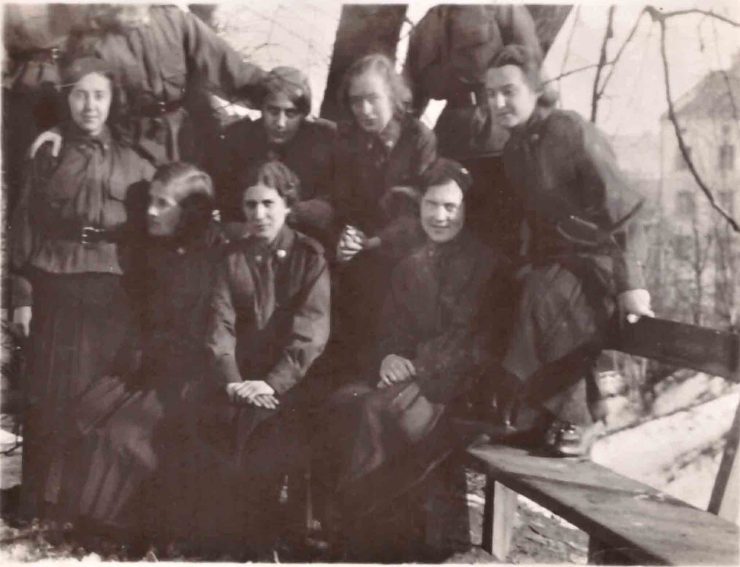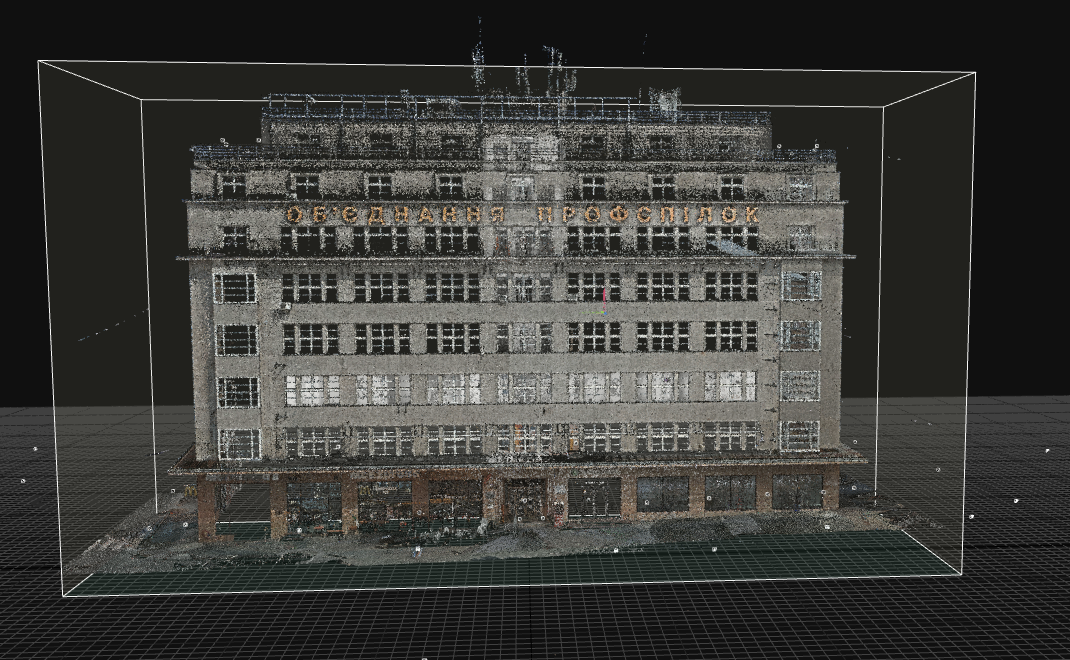Between War and Ideological Change: The School on Tyutyunnykiv Street and Its Students
The intersection of Tiutiunnykiv St. and Arkhypenka St. is home to School №28. Since its construction in 1934, the building has served as an educational institution. In the ’30s, this was a private all-girls prep school, Ursuline Sisters High School; this gave rise to the building’s occasional misnomer ‘convent.’ During the Soviet period, the high school was turned into a school. Presently, it is Lviv City Hall Secondary School №28.

- Constructed: 1934
- Style: functionalism
- Architects: Tadeusz Wróbel Leopold Karasinski

Below are present-day and archive photos of the school and façade elevation [1].
The architects of the school project were Tadeusz Wrubel and Leopold Karasinski [2]. By playing with the volumes of the facade, the authors organically fit the house into the surrounding landscape: the higher part of the house leans against the hill, the lower part opens to the street intersection.
Looking at the façade, it’s easy to see the functional purpose of the interior: the lower section of the building with elongated vertical partitioning of the windows is reserved for the assembly hall and chapel, and the taller section with horizontal window partitioning is where classes and hallways are located. The floor plan is detailed in the drawings below [3].
The middle section connects these sections – risalit , supported by a single column. The main stairwell is also located in this part of the building. The articulation between the window piers, done in yellow clinker brick, adds to the rhythm of the façade.
Evidence that the institution was a religious one can be seen in the semicircular overhang of the chapel altar on the facade facing Archipenko St. A bell tower (now without a bell) also rises above the school. The design also included a figure of a saint on the corner of the building, but it has never been implemented. These details can be seen in the drawings below.
The school’s interior is simple and functional.
The chapel space is particularly noteworthy, as it was turned into a gym after the Soviets took over. Christian worship was replaced by the cult of a healthy, athletic person who was supposed to be an effective cog in the Soviet machine.
The school, indeed, did not have a gym; it was designed but never finished. In the ‘30s, students could do exercises even in a hallway (in the photo below), as spiritual, not physical, education was considered of the utmost importance.
It is through the changes in space that the physical embodiment of the change of ideologies can be traced here. Interestingly, the former chapel still has some of its Art Deco ornaments, including religious depictions such as a hand with a cross with the Latin inscription Dextera Domini, which literally means the hand of God. See how the chapel looked like in the ’30s and how it looks now in the photo below.
As for the high school curriculum, in addition to religious lectures and Polish, the students were taught Latin, geography, biology, history, math, physics, French, gymnastics, music, and drawing.
The students attended an art club held in the assembly hall. Nowadays, the assembly hall still serves the same purpose (pictured below).
Records of the students’ attire remain: on weekdays, the girls wore navy collared blouses and white ones on holidays. The blouses were tucked into just below-the-knee skirts. When not at school, students wore berets with a “U” and navy raincoats. The sleeve was emblazoned with the school’s number patch [4].
The school offered physical education, and girls had gymnastics lessons on the school grounds. They also went to Vynnyky Lake to play volleyball or other sports (see the photo below). It was in the late 1920s that the Republic of Poland, like the rest of the European countries, embraced the trend of raising a healthy, athletic person.
Schools added compulsory physical education classes, started building gyms and swimming pools, and organized outdoor sports competitions. It was a kind of “body politic” that gained momentum in the interwar period. Although Ursuline Sisters High School was quite conservative, physical education was introduced there as well. Part of the fitness training was military training, which included athletic competitions and learning the basics of first aid and medical care [5].
The girls were also preparing for the war in their public service activities. An account of the school’s initiative resonates with us today: in 1939, the students raised funds to buy an air ambulance for the Polish army [6].
A closer look at the students and their lives reveals many stories describing the tragic events of their time. The history of the forced resettlement of Poles from Lviv is the story of a student, Helena Legeżyńska , and her family, who were forced to leave Lviv after the war. After the war, Helena graduated from the Jagiellonian University in Krakow with a degree in chemistry. She lived and worked in Krakow at a public health center [7]. The first photo is of Helena during her high school years; the second was taken in 1943.
The story of resistance is about another Ursuline Sisters High School student, Barbara Otwinowska. She attended the school just before the war. Barbara recounted the first day of the war:
I woke up at four o’clock in the morning and thought: “Dear God, there must be a storm, but somehow it’s so bright outside.” I ran to the window, yet the sun was shining. After a while, my uncle also came to look out of the top floor window and said: “It’s the war.”
[8]
In 1941, Otwinowska went to Warsaw and joined the Home Army. After training as a nurse, she joined the Warsaw Uprising. Barbara also served as a communications officer and a guard in the 100th Company of the Headquarters Company of the Uprising Security Service. This woman survived the Uprising and was taken to Germany as a forced laborer; after the war, she returned to Warsaw, graduated from the University with a degree in Polish Studies, and became a well-known scholar and literature researcher in Poland. The first photo is of Barbara on the day of the Warsaw Uprising, and the second photo was taken after she returned to Warsaw in 1947 [9].
These are just a few of the collected stories about the students of the Ursuline Sisters High School, now Lviv City Hall Secondary School №28. Some of them did not make it through the war, while others lost their homes forever and were never able to come to their school again.
Sources and literature:
[1] Archive materials kindly provided by the administration of Lviv City Hall Secondary School №28
[2] Lewicki, Jakub. Regeneracja i modernizacja. Architektura Lwowa okresu dwudziestolecia międzywojennego. Waraszawa: Narodowy Instytut Polskiego Dziedzictwa Kulturowego za Granicą Polonica, 2021:288
[3] Archive materials kindly provided by the administration of Lviv City Hall Secondary School №28
[4] Biuletyn AUSSI, Nr 3, 2010
[5] Marta Voinarovska in personal communication, 27.04.2023
[6] Biuletyn AUSSI (see ref. 4)
[7] https://pochodzimyzelwowa.pl/helena-z-legezynskich-skarbinska/
[8] file:///D:/DOCs/Downloads/Tak-warto-zyc-Barbara-Otwinowska-19242018.pdf
[9] https://www.muzeumrakowiecka37.pl/post/barbara-otwinowska-1

